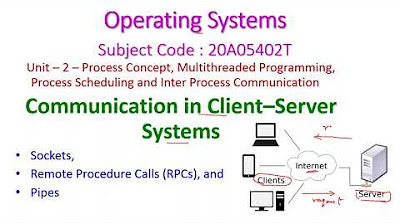Issues in RPC & How They're Resolved
Summary
TLDRThis lecture delves into the intricacies of Remote Procedure Calls (RPC), addressing common issues that arise when executing RPCs across different systems. Key challenges, such as discrepancies in data representation, RPC failures due to network errors, and the complexities of binding client and server port numbers, are discussed. Solutions like machine-independent data representation (XDR), acknowledgment systems, and dynamic binding using a rendezvous mechanism are explored in depth. The lecture concludes with a detailed walkthrough of how an RPC is executed, ensuring clarity on the process and the steps taken to resolve these issues efficiently.
Takeaways
- 😀 RPC (Remote Procedure Call) allows for communication between client and server systems, often located in different places connected via a network.
- 😀 A common issue in RPC is data representation differences between client and server machines (e.g., big-endian vs. little-endian), which is resolved using External Data Representation (XDR).
- 😀 XDR ensures data is represented in a machine-independent format, so data can be transferred between different systems without compatibility issues.
- 😀 RPC can fail or experience duplicate executions due to network errors, which is a significant concern compared to local procedure calls.
- 😀 To handle network-related issues, operating systems ensure RPC messages are acted on 'exactly once,' avoiding duplication or loss of calls.
- 😀 The system uses an acknowledgment mechanism where the server sends confirmation to the client that the RPC was successfully executed, ensuring reliability.
- 😀 A key issue in RPC is binding, where the client and server need to resolve port numbers to correctly route procedure calls, despite not sharing memory.
- 😀 One solution to binding issues is the use of fixed port addresses assigned at compile time, but this can be inflexible.
- 😀 A more flexible solution uses a rendezvous mechanism, where a matchmaker daemon dynamically resolves port numbers based on procedure names.
- 😀 The client sends a request for the port number to the matchmaker daemon, which then replies with the port number, allowing the RPC to be executed without fixed addresses.
- 😀 The complete RPC execution involves the client sending a message to the server through the kernel, resolving port numbers via the matchmaker, and receiving results from the server after execution.
Q & A
What is the main focus of this lecture on RPC?
-The main focus of the lecture is on the issues faced during the execution of Remote Procedure Calls (RPC) and how these issues are resolved, with a detailed explanation of data representation problems, network failure issues, and binding problems.
What is the issue of data representation in RPC?
-The issue arises because the client and server machines may have different ways of representing data. For example, some systems use big-endian while others use little-endian for storing 32-bit integers, which can lead to errors when transferring data between these systems.
How is the data representation issue in RPC resolved?
-The issue is resolved by using an external data representation (XDR), which is machine-independent. The client converts its data into XDR format before sending it, and the server converts the data back to its machine-dependent format when received.
What are the potential network issues faced during RPC execution?
-Network issues can lead to RPC calls failing, being duplicated, or being executed more than once due to network errors. These issues arise because RPCs operate over a network, which is prone to errors like packet loss or delays.
How can RPC failures and duplications due to network issues be handled?
-To handle this, RPC systems ensure that messages are acted upon 'exactly once.' This is achieved through an acknowledgment system where the client resends the request until it receives an acknowledgment from the server, confirming that the RPC has been executed successfully.
What does the term 'exactly once' mean in the context of RPCs?
-The term 'exactly once' means ensuring that an RPC is executed only once, without duplication, even if there are network errors. This is achieved by the client waiting for an acknowledgment from the server before sending the request again.
What is the issue with binding in RPCs?
-The issue with binding arises because the client and server do not share memory and are on different machines, so the client may not know the server's port numbers or addresses for RPCs. This makes it difficult for the client to send requests to the correct server port.
How is binding handled in RPCs?
-Binding can be handled in two ways: 1) Fixed port addresses that are determined at compile-time, or 2) A dynamic binding mechanism using a rendezvous daemon (also known as a matchmaker) that helps the client dynamically determine the correct port number for the procedure call.
What is the role of a rendezvous daemon in RPC?
-A rendezvous daemon acts as a matchmaker between the client and server. The client sends the name of the RPC procedure to the daemon, which looks up the correct port address for the procedure and returns it to the client, allowing the client to send the request to the correct server port.
Can the client and server change port numbers during RPC execution?
-In the fixed port number method, port numbers are predetermined and cannot be changed. However, in the dynamic binding approach using the rendezvous daemon, port numbers can change because the daemon dynamically resolves the correct port each time a procedure call is made.
Outlines

This section is available to paid users only. Please upgrade to access this part.
Upgrade NowMindmap

This section is available to paid users only. Please upgrade to access this part.
Upgrade NowKeywords

This section is available to paid users only. Please upgrade to access this part.
Upgrade NowHighlights

This section is available to paid users only. Please upgrade to access this part.
Upgrade NowTranscripts

This section is available to paid users only. Please upgrade to access this part.
Upgrade Now5.0 / 5 (0 votes)





